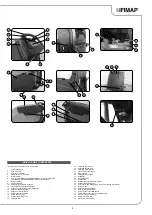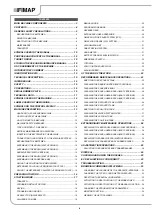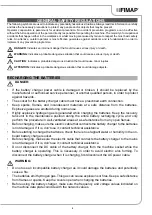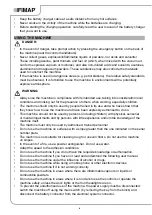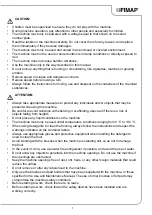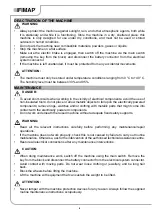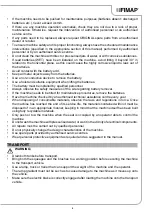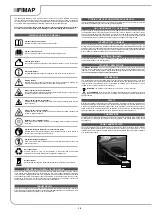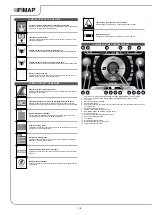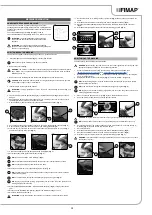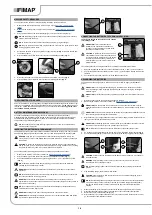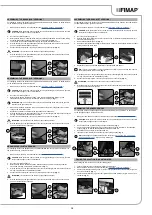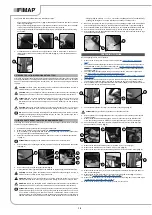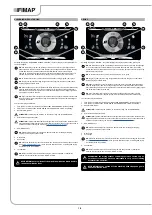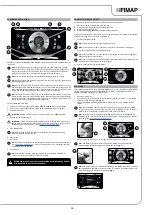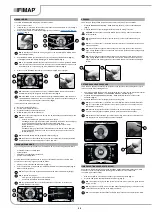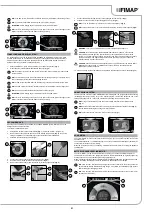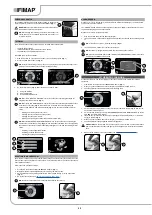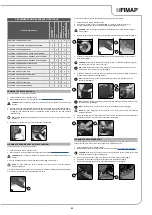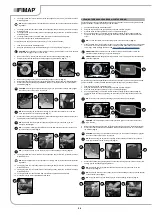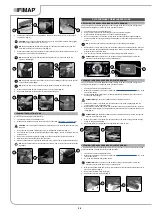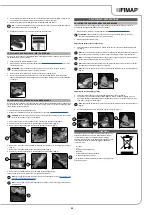
MACHINE SAFETY MEASURES
To ensure that work is carried out in the best safety conditions, proceed as follows:
1. Make sure the solution tank is empty. If it isn't, empty it (see “
”).
2. Make sure the recovery tank is empty. If it isn't, empty it (see “
”).
3. Using the DS selector on the control display (
Fig. 1
), select the “transfer” program” (1).
NB
: with this working program, both the brush head and the squeegee support are in the idle
position (raised from the floor).
NB
: on the DS selector, the symbol of the transport program (1) is green (
Fig. 1
).
NB
: the grey symbols show working programs that are not active. the green symbols show
working programs that are active.
4. Set the main switch to “0” position by turning the key (2) to the left (
Fig. 2
). Remove the key from
the instrument panel.
5. Grip the handle (3) and raise the recovery tank to the maintenance position (
Fig. 3
).
6. Disconnect the battery connector from the main machine system connector (
Fig. 4
).
7. Grip the handle (3) and rotate the recovery tank to its working position (
Fig. 5
).
TYPE OF BATTERY TO BE USED
Power to the machine must be supplied by two sealed traction batteries with gas recombination or gel
technology. The batteries must meet the requirements laid out in the norms: CEI EN 60254-1:2005-12
(CEI 21-5) + CEI EN 60254-2:2008-06 (CEI 21-7). For the best work results,
we suggest the use of
two 12V MFP 112 Ah/C
5
batteries
.
BATTERY MAINTENANCE AND DISPOSAL
For battery maintenance and recharging, respect the instructions provided by the battery
manufacturer. When the batteries reach the end of their service life, they must be disconnected by
specialised and properly trained personnel, and must be subsequently removed from the battery
compartment using suitable lifting devices.
NB
: dead batteries are classified as dangerous waste and as such must be delivered to an
authorised body for disposal.
INSERTING THE BATTERIES IN THE MACHINE
The batteries must be housed in the relative compartment beneath the recovery tank. They should be
handled using lifting equipment that is suitable in terms of both the weight and the coupling system.
DANGER
: make sure you comply with the accident prevention regulations in force in the
country where you work or with DIN EN 50272-3 and DIN EN 50110-1, before any handling of
the batteries.
CAUTION
: to prevent an accidental short circuit use insulated tools to connect the batteries,
and do not place or drop metal objects on the battery. Remove rings, watches and any clothing
with metal parts that may come into contact with the battery terminals.
The various phases for inserting the batteries in the battery compartment are as follows:
1. Make sure the machine is in a safe condition (see “
”).
2. Grip the handle (1) and raise the recovery tank to the maintenance position (
Fig. 1
).
3. House the batteries in the compartment, positioning the poles “+” and “-” opposite each other
(
Fig. 2
).
NB
: for battery maintenance and daily recharging, you must fully respect the indications
provided by the manufacturer or retailer.
WARNING
: all installation and maintenance operations must be carried out by specialised
personnel.
NB
: before installing the battery, clean the battery compartment. Check that the connectors on
the cables supplied are functioning correctly.
WARNING
: check that the characteristics of the battery that you are looking to use are
appropriate for the type of work to be performed. Check the battery charge and the condition of
the contacts on the battery.
NB
: you are advised to only lift and move the batteries with lifting and transportation means
suitable for the specific weight and size
WARNING
: the lifting hooks must not damage the blocks, connectors or cables.
WARNING
: before inserting the batteries, remember to cover the terminals with a little grease
to protect them against external corrosion.
CONNECTING THE BATTERIES TO THE MACHINE SYSTEM
The batteries should be connected so as to obtain a
total voltage of 24V.
ATTENTION
: it is recommended that all
installation and maintenance operations be
carried out by expert personnel, trained at the
specialised assistance centre.
CAUTION
: to prevent an accidental short circuit
use insulated tools to connect the batteries, and
do not place or drop metal objects on the battery.
Remove rings, watches and any clothing with
metal parts that may come into contact with the
battery terminals.
The various phases for inserting the batteries in the battery compartment are as follows:
1.
Using the supplied jumper cable (1), connect the batteries to the “+” and “-” poles in sequence.
2. Connect the battery connector cable (2) to the “+” and “-” poles to obtain a voltage of 24V at the
terminals.
3. Connect the electric system connector (3) to the battery connector (2).
RECHARGING THE BATTERIES
The batteries must be charged prior to first use, and whenever they no longer provide sufficient
power.
ATTENTION
: to avoid any permanent damage to the batteries, it is essential to avoid their
complete discharge; begin recharging them within a few minutes of noting the “discharged
batteries” signal.
ATTENTION
: never leave the batteries completely discharged, even if the device is not being
used.
1. Bring the appliance to the area where the batteries are charged.
2. Make sure the machine is in a safe condition (see “
”).
ATTENTION
: park the machine in an enclosed place, on a flat and level surface; near the
machine there must be no objects that could either damage it, or be damaged through contact
with it.
ATTENTION
: the room used to recharge the batteries must be adequately ventilated to prevent
the accumulation of gases that leak from batteries.
3. Grip the handle (1) on the right-hand side of the recovery tank (
Fig. 1
) and turn the tank as far as
it will go, until it reaches the maintenance position.
ATTENTION
: the following operations must be carried out by qualified personnel. An incorrect
connection of the connector may cause a malfunction of the device.
NB
: carefully read the use and maintenance instructions of the battery charger used.
4. Go to the back of the machine and remove the cap (2) from the battery charger socket (
Fig. 2
).
5. Connect the battery charger power cable connector (3) to the battery charger socket (4) (
Fig. 3
).
CAUTION
: before connecting the batteries to the battery charger, make sure it is suitable for
the batteries used.
WARNING
: before inserting the connector (3) in the socket (4), make sure there is no
condensation or any other type of liquid.
NB
: the battery charger power cable is delivered inside the bag containing this instruction
booklet.
6. Plug the battery charger cable into the mains socket.
CAUTION
: keep the recovery tank open for the duration of the battery recharging cycle, to
allow gas fumes to escape.
NB
: before connecting the battery charger to the mains socket, make sure the characteristics
of the mains supply correspond to those required by the battery charger. Read the battery
charger use and maintenance manual (included in the bag that contains this instruction
booklet).
7. When the recharge cycle is complete, disconnect the battery charger cable from the mains.
8. Disconnect the battery charger power cable from the socket on the battery charger itself.
9. Replace the cap (2) on the battery charger plug.
10. Grip the handle (1) on the right-hand side of the recovery tank and turn the tank as far as it will
go, until it reaches the maintenance position.
14
Back
0000.00
100%
1
2
2
1
3
3
5
4
2
1
2
2
3
1
2
3
1
1
2
4
3
Summary of Contents for MAXIMA 2017 PLUS
Page 2: ......
Page 36: ...36 NOTE ...
Page 37: ...37 NOTE ...
Page 38: ...38 NOTE ...
Page 39: ......



